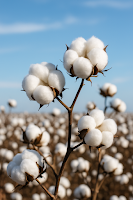How to Grow Cotton Successfully: A Complete Guide for Maximum Yield & Profit
Cotton cultivation is one of the most profitable agricultural activities worldwide, especially in regions with suitable climate conditions. If you're wondering how to grow cotton, looking for the best time to plant cotton, or exploring the profitability of cotton farming, you're in the right place.
This comprehensive guide will walk you through every stage of cotton farming — from seed selection to harvesting — with proven tips and up-to-date insights to help you maximize both productivity and profit.
What Is Cotton and Why Is It Called “White Gold”?
Cotton is a fibrous plant used in textile manufacturing, oils, and animal feed. Grown in over 80 countries, cotton is one of the most important cash crops globally.
Why is it called white gold? Because it provides consistent income for farmers, supports the textile industry, and is fully utilized — from seed to fiber to by-products.
Best Time to Plant Cotton
The ideal planting time for cotton depends on your local climate. Here’s a quick overview:
| Region | Optimal Planting Time |
|---|---|
| Hot regions | March – May |
| Moderate climates | April – June |
| Semi-arid zones | February – April |
Pro Tip: Ensure soil temperatures are at least 18°C (64°F) for optimal germination.
Environmental Requirements for Cotton Farming
- Climate: Warm and sunny (25–35°C).
- Soil: Sandy loam with good drainage and pH between 5.5 and 7.5.
- Irrigation: Drip irrigation is ideal to conserve water and reduce disease.
- Sunlight: Minimum of 6 hours of direct sun per day.
Step-by-Step Cotton Planting Guide
1. Choosing the Right Seeds
Select disease-resistant, high-yielding cotton varieties that are adapted to your region.
2. Preparing the Soil
- Deep tillage to aerate the soil
- Remove weeds and previous crop residues
- Add compost or organic manure
3. Planting the Seeds
- Planting depth: 4–5 cm
- Spacing: 20–30 cm between plants, 60–90 cm between rows
4. Irrigation & Fertilization
| Growth Stage | Recommended Fertilizer |
|---|---|
| Vegetative | Nitrogen + Phosphorus |
| Flowering | Potassium + Calcium |
| Pre-harvest | Reduce irrigation to prevent flower drop |
5. Pest Management
Major pests: Bollworm, whiteflies, thrips.
Use integrated pest management strategies such as biological pesticides, crop rotation, and pheromone traps.
When to Harvest Cotton
Cotton is usually ready for harvest after 5–6 months. Indicators include:
- Bolls open naturally
- Plants turn brown and leaves dry up
- Fibers are fluffy and white
Note: Avoid delayed harvest to prevent fiber loss due to rain or pests.
Is Cotton Farming Profitable?
Yes, especially when managed properly. Here’s an estimated breakdown of cost and profit per acre:
| Item | Cost (per acre) |
|---|---|
| Seeds | $50–70 |
| Fertilizer & Irrigation | $100–150 |
| Pest Control | $70–100 |
| Total Cost | $250–300 |
| Expected Profit | $600–1000 |
Frequently Asked Questions (FAQ)
Does cotton need a lot of water?
Yes, but avoid overwatering. Drip irrigation is highly recommended.
Can cotton be grown at home?
Yes, but only for educational or ornamental purposes — not commercially viable.
Is cotton environmentally harmful?
Excessive pesticide use can be harmful, but organic cotton is an eco-friendly alternative.
Conclusion
Cotton farming is a smart agricultural investment if done correctly. With the right seed selection, soil preparation, pest control, and irrigation management, you can enjoy a productive and profitable harvest season.
Plan your next farming cycle with cotton and join the farmers who are harvesting “white gold” each year!



